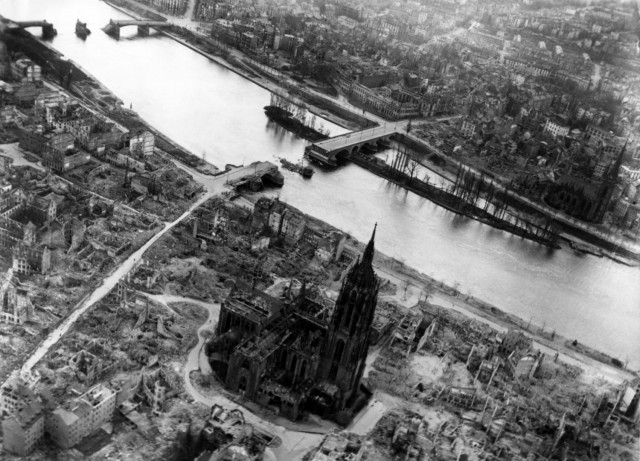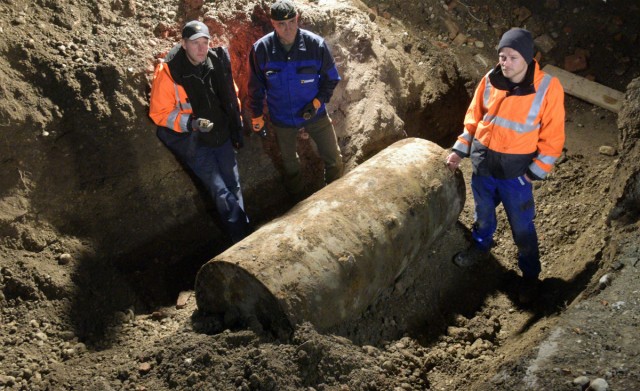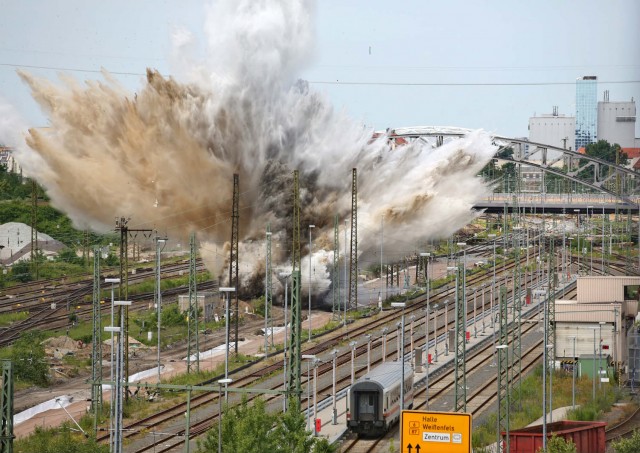Everything you need to know about WWII bomb disposals in Germany

Some 70,000 people in Frankfurt will have to leave their homes on Sunday in the biggest evacuation in post-war Germany due to an unexploded Second World War bomb. But finding such bombs and subsequent evacuations is quite common.
What's the history of Frankfurt in relation to the Second World War?
Frankfurt suffered greatly during the Second World War. About 5,500 residents perished and the city’s medieval city centre - one of the largest in Germany at the time - was destroyed.
Tens of thousands of tonnes of explosives were dropped on the city.
Between 1940 and 1945, British and American bombers dropped 1.35 million tonnes of bombs all across Germany. In 1944 alone, the Allies put down 650,000 tonnes of explosives and fire bombs across German cities and industrial areas.
 A view of Frankfurt from above in 1944. Photo: Creative Commons.
A view of Frankfurt from above in 1944. Photo: Creative Commons.
In Frankfurt, raging fires took down almost all of the well-known cultural buildings, and over 1,800 timbered buildings in the city were destroyed.
Just under half of the homes in the city area were destroyed as well.
At the end of the war the population of Frankfurt had dropped from 553,000 people to 230,000.
SEE ALSO: Largest ever evacuation set to take place in Frankfurt after WWII bomb found
How often are Second World War bombs found?
Discovering bombs from the past is an everyday thing in Germany.
In 2011 it was estimated that over 5,500 unexploded bombs or weapons including shells, grenades, mines, and ammunition from the Second World War that need to be defused are uncovered each year. The daily average is 15, most of them aerial bombs.
They land in fishing nets, are pulled up by excavators during road construction work, or inadvertently removed from fields by farmers.
While no one knows exactly how many still lurk under the ground, we live on top of an estimated more than 100,000 bombs, all of which have the potential to cause catastrophes. Especially affected are the areas which were heavily bombarded during the Second World War - the Ruhr district, Cologne, Hamburg, and Berlin, but also smaller cities like Wesel or Koblenz.
The number of evacuations that take place in Germany each year varies depending on the severity and size of the bomb. Over the past few years, many evacuations have taken place across the country.
 The bomb uncovered in Augsburg in 2016. Photo: DPA.
The bomb uncovered in Augsburg in 2016. Photo: DPA.
In May this year, 50,000 people in Hanover had to evacuate due to several bombs which were found in the area. Comparatively fewer people - 200 residents - were forced to temporarily leave their homes near Munich in March this year. So the number of residents who need to evacuate during a bomb disposal varies greatly.
The largest evacuation yet after the Second World War was due to a 3.8 tonne British-made bomb found in Augsburg, meaning around 54,000 people had to leave their homes on Christmas Eve last year.
A smaller Russian 250 kilogram bomb found in a Berlin neighbourhood last November led to the evacuation of a hospital, a kindergarten and a care home.
How safe are bomb disposals and evacuations?
Bombs from the Second World War continue to pose a considerable threat. Since so many of them haven’t been detected, the explosive bodies are still intact and therefore just as dangerous as during the war.
They can also become increasingly sensitive by ageing and external influences such as vibrations, changes in position or temperature fluctuations can lead to them exploding.
It’s rare though for people nowadays to be killed or injured by accidental explosions.
In November 2013, the defusing of a 10 tonne bomb in Brandenburg resulted in significant damage. A home was destroyed and had to be demolished. Several other buildings were also damaged.
In 2012, the disposal of a 250 kilogram American bomb in the centre of Munich was unsuccessful. Facades were damaged and numerous windows were broken.
Three people were killed and two seriously injured in a routine bomb disposal in Göttingen in June 2010.
Back in 1994, three construction workers were killed in Berlin when a bomb exploded in a construction pit. Several buildings and cars were severely damaged.
Two explosives experts in Hesse died during the defusing of a bomb in August 1990.
 A controlled explosion of a WWII bomb in Leipzig in 2014. Photo: DPA
A controlled explosion of a WWII bomb in Leipzig in 2014. Photo: DPA
What's the typical protocol during a bomb evacuation?
When a Second World War bomb is found in Germany, immediate measures must be taken.
Any disposal is accompanied by extensive closures and the evacuation of the direct surroundings. Affected residential areas must be evacuated for a few hours while explosives experts move in.
People who live or work near the bomb must evacuate. This is not a request, but an arrangement that residents must follow for their own safety.
Residents can be forced by officials at the municipal office to leave their homes if they refuse to comply.
For the period of disposal, the city usually provides an assembly point where residents can stay. The employees of the municipal office, the fire department and the police let people know of the location as soon as it is determined.
It is not possible to say ahead of a bomb disposal how long the evacuation will take. Residents are usually required to spend several hours away from their homes before it is safe to return.
The airspace near the bomb site may also be blocked, as well as all railway lines within the affected radius and all footpaths in the immediate area.
The upcoming bomb disposal in Frankfurt for instance could have a short-term impact on air traffic for airplanes arriving at Germany’s largest airport.
Which areas will be affected in Frankfurt on Sunday?
Around 70,000 people will have to leave their homes for a few hours after a so-called Wohnblockknacker (block buster) was found in a construction area in Frankfurt’s west end.
The ordnance was found close to the city centre, just about 2.5 kilometres north of the main Zeil shopping area.
Residents within a radius of 1.5 kilometres of the bomb must evacuate. Among the affected buildings are the German Federal Bank and two hospitals. The Frankfurt police headquarters and the headquarters of broadcaster Hessischer Rundfunk are also located in the restricted zone.
This tweet from the police in Frankfurt highlights the area which will have to be vacated.
Hier der vorläufige Evakuierungsbereich für die Entschärfung der #Weltkriegsbombe im #Westend #Ffm, am kommenden Sonntag pic.twitter.com/MO9JFBbxRF
— Polizei Frankfurt (@Polizei_Ffm) August 30, 2017
Police expect Sunday's evacuation to be completed by midday so that they can get on with disposing of the bomb.
What are the challenges of bomb disposals and evacuations today?
Nowadays the main challenge with regard to bomb disposals in Germany is not safety, but rather, logistics.
In Frankfurt on Sunday for instance, the authorities are presented with enormous logistical challenges despite the fact that no danger for residents is expected.
Local transport will be affected as several bus and subway routes will either be interrupted or discontinued.
A telephone line has been set up to answer local residents' questions at 069 21 21 11.
The fire brigade and police in Frankfurt will also be announcing details online as to when the evacuation will end and when it will be safe for people to go back to their homes. In the meantime they suggest following their Twitter account @Polizei_Ffm for the most up to date information.
The fire brigade has so far not disclosed any further details as to the emergency plan for older and bedridden residents. In the past, it was always the case that these residents were able to report to the fire brigade under a special phone number. They were then picked up by rescue workers immediately before their evacuation.
More details regarding the mass evacuation in Frankfurt are expected on Friday.
With DPA
Comments
See Also
What's the history of Frankfurt in relation to the Second World War?
Frankfurt suffered greatly during the Second World War. About 5,500 residents perished and the city’s medieval city centre - one of the largest in Germany at the time - was destroyed.
Tens of thousands of tonnes of explosives were dropped on the city.
Between 1940 and 1945, British and American bombers dropped 1.35 million tonnes of bombs all across Germany. In 1944 alone, the Allies put down 650,000 tonnes of explosives and fire bombs across German cities and industrial areas.
 A view of Frankfurt from above in 1944. Photo: Creative Commons.
A view of Frankfurt from above in 1944. Photo: Creative Commons.
In Frankfurt, raging fires took down almost all of the well-known cultural buildings, and over 1,800 timbered buildings in the city were destroyed.
Just under half of the homes in the city area were destroyed as well.
At the end of the war the population of Frankfurt had dropped from 553,000 people to 230,000.
SEE ALSO: Largest ever evacuation set to take place in Frankfurt after WWII bomb found
How often are Second World War bombs found?
Discovering bombs from the past is an everyday thing in Germany.
In 2011 it was estimated that over 5,500 unexploded bombs or weapons including shells, grenades, mines, and ammunition from the Second World War that need to be defused are uncovered each year. The daily average is 15, most of them aerial bombs.
They land in fishing nets, are pulled up by excavators during road construction work, or inadvertently removed from fields by farmers.
While no one knows exactly how many still lurk under the ground, we live on top of an estimated more than 100,000 bombs, all of which have the potential to cause catastrophes. Especially affected are the areas which were heavily bombarded during the Second World War - the Ruhr district, Cologne, Hamburg, and Berlin, but also smaller cities like Wesel or Koblenz.
The number of evacuations that take place in Germany each year varies depending on the severity and size of the bomb. Over the past few years, many evacuations have taken place across the country.
 The bomb uncovered in Augsburg in 2016. Photo: DPA.
The bomb uncovered in Augsburg in 2016. Photo: DPA.
In May this year, 50,000 people in Hanover had to evacuate due to several bombs which were found in the area. Comparatively fewer people - 200 residents - were forced to temporarily leave their homes near Munich in March this year. So the number of residents who need to evacuate during a bomb disposal varies greatly.
The largest evacuation yet after the Second World War was due to a 3.8 tonne British-made bomb found in Augsburg, meaning around 54,000 people had to leave their homes on Christmas Eve last year.
A smaller Russian 250 kilogram bomb found in a Berlin neighbourhood last November led to the evacuation of a hospital, a kindergarten and a care home.
How safe are bomb disposals and evacuations?
Bombs from the Second World War continue to pose a considerable threat. Since so many of them haven’t been detected, the explosive bodies are still intact and therefore just as dangerous as during the war.
They can also become increasingly sensitive by ageing and external influences such as vibrations, changes in position or temperature fluctuations can lead to them exploding.
It’s rare though for people nowadays to be killed or injured by accidental explosions.
In November 2013, the defusing of a 10 tonne bomb in Brandenburg resulted in significant damage. A home was destroyed and had to be demolished. Several other buildings were also damaged.
In 2012, the disposal of a 250 kilogram American bomb in the centre of Munich was unsuccessful. Facades were damaged and numerous windows were broken.
Three people were killed and two seriously injured in a routine bomb disposal in Göttingen in June 2010.
Back in 1994, three construction workers were killed in Berlin when a bomb exploded in a construction pit. Several buildings and cars were severely damaged.
Two explosives experts in Hesse died during the defusing of a bomb in August 1990.
 A controlled explosion of a WWII bomb in Leipzig in 2014. Photo: DPA
A controlled explosion of a WWII bomb in Leipzig in 2014. Photo: DPA
What's the typical protocol during a bomb evacuation?
When a Second World War bomb is found in Germany, immediate measures must be taken.
Any disposal is accompanied by extensive closures and the evacuation of the direct surroundings. Affected residential areas must be evacuated for a few hours while explosives experts move in.
People who live or work near the bomb must evacuate. This is not a request, but an arrangement that residents must follow for their own safety.
Residents can be forced by officials at the municipal office to leave their homes if they refuse to comply.
For the period of disposal, the city usually provides an assembly point where residents can stay. The employees of the municipal office, the fire department and the police let people know of the location as soon as it is determined.
It is not possible to say ahead of a bomb disposal how long the evacuation will take. Residents are usually required to spend several hours away from their homes before it is safe to return.
The airspace near the bomb site may also be blocked, as well as all railway lines within the affected radius and all footpaths in the immediate area.
The upcoming bomb disposal in Frankfurt for instance could have a short-term impact on air traffic for airplanes arriving at Germany’s largest airport.
Which areas will be affected in Frankfurt on Sunday?
Around 70,000 people will have to leave their homes for a few hours after a so-called Wohnblockknacker (block buster) was found in a construction area in Frankfurt’s west end.
The ordnance was found close to the city centre, just about 2.5 kilometres north of the main Zeil shopping area.
Residents within a radius of 1.5 kilometres of the bomb must evacuate. Among the affected buildings are the German Federal Bank and two hospitals. The Frankfurt police headquarters and the headquarters of broadcaster Hessischer Rundfunk are also located in the restricted zone.
This tweet from the police in Frankfurt highlights the area which will have to be vacated.
Hier der vorläufige Evakuierungsbereich für die Entschärfung der #Weltkriegsbombe im #Westend #Ffm, am kommenden Sonntag pic.twitter.com/MO9JFBbxRF
— Polizei Frankfurt (@Polizei_Ffm) August 30, 2017
Police expect Sunday's evacuation to be completed by midday so that they can get on with disposing of the bomb.
What are the challenges of bomb disposals and evacuations today?
Nowadays the main challenge with regard to bomb disposals in Germany is not safety, but rather, logistics.
In Frankfurt on Sunday for instance, the authorities are presented with enormous logistical challenges despite the fact that no danger for residents is expected.
Local transport will be affected as several bus and subway routes will either be interrupted or discontinued.
A telephone line has been set up to answer local residents' questions at 069 21 21 11.
The fire brigade and police in Frankfurt will also be announcing details online as to when the evacuation will end and when it will be safe for people to go back to their homes. In the meantime they suggest following their Twitter account @Polizei_Ffm for the most up to date information.
The fire brigade has so far not disclosed any further details as to the emergency plan for older and bedridden residents. In the past, it was always the case that these residents were able to report to the fire brigade under a special phone number. They were then picked up by rescue workers immediately before their evacuation.
More details regarding the mass evacuation in Frankfurt are expected on Friday.
With DPA
Join the conversation in our comments section below. Share your own views and experience and if you have a question or suggestion for our journalists then email us at [email protected].
Please keep comments civil, constructive and on topic – and make sure to read our terms of use before getting involved.
Please log in here to leave a comment.